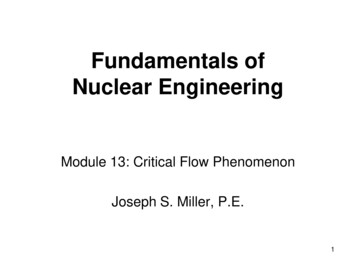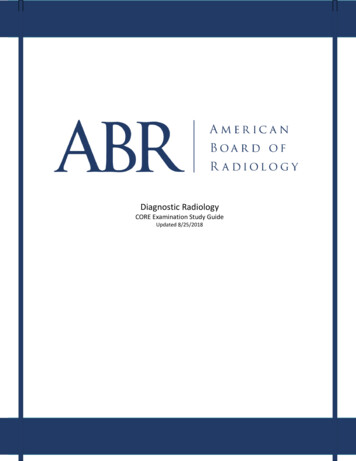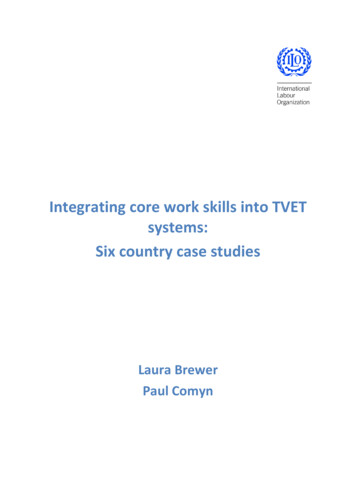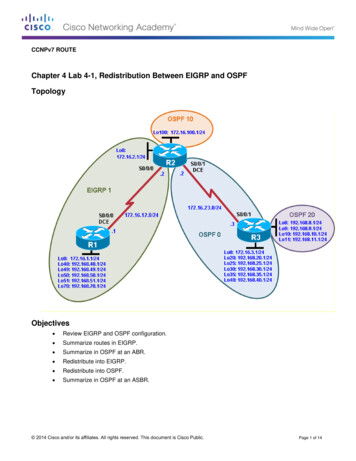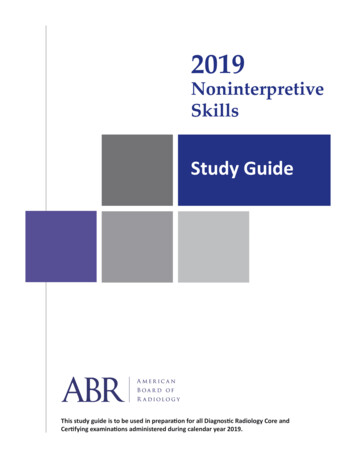
Transcription
2019NoninterpretiveSkillsStudy GuideThis study guide is to be used in preparation for all Diagnostic Radiology Core andCertifying examinations administered during calendar year 2019.
Table of ContentsIntroduction.iiiChapter 1. Core Elements of Professionalism.11.1 ABIM Physician Charter for Medical Professionalism in the New Millennium. 11.2 Ethical Considerations Specific to Radiology. 2Chapter 2. Core Concepts of Quality and Safety.42.1 Core Concepts of Quality. 42.1.1 Introduction to Quality. 4.2.1.2 Quality as a Discipline. 4.2.1.3 2001 Institute of Medicine Report, Crossing the Quality Chasm. 5.2.1.4 Core Competencies of the ABMS and ACGME. 52.2 Core Concepts of Safety. 6.2.2.1 2000 Institute of Medicine Report, To Err is Human. 62.2.2 2015 Institute of Medicine Report, Improving Diagnosis in Health Care. 62.2.3 Human Factors. 72.2.4 Human Error. 92.2.5 Culture of Safety. 9Chapter 3. Practical Quality and Safety Applications in Healthcare.123.1 Practical Quality Applications in Healthcare. 12.3.1.1 Daily Management Systems. 12.3.1.2 Project-based Improvement Methods. 133.2 Practical Safety Applications in Healthcare. 17.3.2.1 Periprocedural Care. 17.3.2.2 Hand Hygiene. 19.3.2.3 Root Cause Analysis. 20Chapter 4. Practical Safety Applications in Radiology.214.1 MR Safety. 214.1.1 Zoning and Screening. 21.4.1.2 Intracranial Aneurysm Clips and Pacemakers. 22.4.1.3 MR and Pregnancy. 224.1.4 MR-induced Burns. 22.4.1.5 Quenching. 23.4.2 Management of Intravascular Contrast Media. 23.4.2.1 Iodinated Contrast Media. 23.4.2.2 Gadolinium-based Contrast Media (GBCM) . 29.4.2.3 Treatment of Acute Contrast Reactions . 31Chapter 5. Reimbursement, Regulatory Compliance, and Legal Considerations in Radiology.32.5.1 Reimbursement and Regulatory Compliance. 325.1.1 Coding, Billing, and Reimbursement. 32.5.1.2 Patient Privacy and HIPAA. 35.5.1.3 Human Subjects Research. 35.5.2 Malpractice and Risk Management. 36.5.2.1 General Principles of Malpractice. 36.5.2.2 Malpractice Related to Diagnostic Errors. 37.5.2.3 Malpractice Related to Procedural Complications. 37.5.2.4 Malpractice Related to Communications Deficiencies. 38.5.2.5 Discoverability of Communications. 392019 Noninterpretive Skills Study Guidei
Table of Contents, continuedChapter 6. Core Concepts of Imaging Informatics.416.1 Standards. 416.2 The Reading Room Environment. 426.3 From Order to Report: Workflow Considerations. 42.6.4 Data Privacy and Security. 43.6.5 Image Post-processing. 432019 Noninterpretive Skills Study Guideii
IntroductionThis study guide has been created to assist examinees in preparing for the noninterpretive skills (NIS) section ofthe American Board of Radiology (ABR) Core and Certifying examinations administered between January 1 –December 31, 2018.The guide has undergone a few minor changes compared to the 2018 version, which was significantly revised compared to earlier versions, reflecting changes in NIS content on the examinations. The primary change in this studyguide is the addition of Core Concepts of Imaging Informatics. Details of contrast safety and MR safety have alsobeen updated, reflecting new published findings.The determination of whether specific NIS topics merit inclusion in the study guide—and on the examinations—isbased primarily on two factors. First, material contained in the NIS section should reflect knowledge that is neededto perform effectively in a modern radiology practice. Second, the public interest should be served by expectingthe examinee to know the material.Core Elements of Professionalism were deemed to merit inclusion because they reflect basic principles to which allphysicians, including radiologists, should adhere. Core Concepts of Quality and Safety were included because theyreflect underlying principles that drive quality and safety in any complex environment. Practical Quality and SafetyApplications in Healthcare contain quality and safety strategies as they are applied to healthcare. Practical SafetyApplications in Radiology focus on radiology-specific topics such as MR safety and management of intravenouscontrast material. Reimbursement, Regulatory Compliance, and Legal Considerations in Radiology reflect mechanisms that external parties use to ensure quality and safety in radiology practice.The guide covers the majority of general conceptual and practical NIS information contained in the Core andCertifying examinations. However, questions on important subspecialty-specific quality and safety knowledge andskills are also included on the examinations that are not included in this guide, especially those related to nuclearmedicine and other procedure-based specialties. Examinees should be knowledgeable in basic quality and safetypractices relevant to all subspecialties regardless of whether they are included in this study guide. Physics topics, including radiation safety, remain on the examination but are no longer included in the NIS section. Contentrelated to research methodology and Bayesian statistics, included in previous versions, has been removed from thestudy guide and the examinations.Examinees are expected to understand general NIS concepts rather than esoteric details. For example, examineesshould understand the basics elements of regulatory requirements commonly found in radiology practice, as wellas their underlying purpose. Less emphasis is placed on more superficial details, such as the names of the variousregulatory agencies.It is expected that this study guide will continue to evolve in future years to reflect continuing changes in the noninterpretive knowledge and skills needed to practice effectively in a modern radiology practice.We also draw your attention to the references provided at the end of each chapter. We recommend that you consult these “deeper” resources, which provide perspective and depth of understanding of the concepts that are onlysuperficially outlined in this study guide.2019 Noninterpretive Skills Study Guideiii
1Core Elements of Professionalism1.1 ABIM Physician Charter for MedicalProfessionalism in the New MillenniumMerriam-Webster defines a profession as “a callingrequiring specialized knowledge and often long and intensive academic preparation.” Professionalism, definedas “the conduct, aims, or qualities that characterize ormark a profession or a professional person,” has beencharacterized as the basis of medicine’s contract withsociety.Several fundamental principles and physician responsibilities that apply to all professionals in medicine havebeen specified in a Physician Charter supported by theAmerican Board of Internal Medicine (ABIM). Tenprofessional responsibilities support the following threefundamental principles of medical professionalism:1. Principle of primacy of patient welfare.Physicians must be dedicated to serving theinterest of the patient. Trust is central to thephysician-patient relationship, which mustnot be compromised by market forces, societalpressures, or administrative exigencies.2. Principle of patient autonomy. Physiciansmust be honest with their patients andempower them to make informed decisionsabout their treatment. Patients’ decisions abouttheir care must be paramount, as long as theyare in keeping with ethical practice and do notlead to demands for inappropriate care.3. Principle of social justice. The medicalprofession must promote the fair distributionof healthcare resources. Physicians shouldwork actively to eliminate discrimination inhealthcare.The 10 professional responsibilities are summarizedbelow:1. Commitment to professional competence.Physicians must be committed to lifelonglearning of medical knowledge and teamCore Elements of Professionalismskills necessary for the provision of qualitycare. More broadly, the profession as a wholemust strive to see that all of its members arecompetent and must ensure that appropriatemechanisms are available for physicians toaccomplish this goal.2. Commitment to honesty with patients.Physicians must ensure that patients arecompletely and honestly informed beforethe patient has consented to treatmentand after treatment has occurred. Medicalerrors should be communicated promptlyto patients whenever injury has occurred.Physicians should be committed to reportingand analyzing medical mistakes to developappropriate prevention and improvementstrategies.3. Commitment to patient confidentiality.Physicians are responsible for safeguardingpatient information. Fulfilling this commitmentis more pressing now than ever before, giventhe widespread use of electronic informationsystems. However, considerations of publicinterest may occasionally override thiscommitment, such as when patients endangerothers.4. Commitment to maintaining appropriaterelations with patients. Given the inherentvulnerability and dependency of patients,certain relationships between physiciansand patients must be avoided. In particular,physicians should never exploit patients for anysexual advantage, personal financial gain, orother private purpose.5. Commitment to improving quality of care.Physicians should not only maintain clinicalcompetence, but should work collaborativelywith other professionals to continuouslyimprove the quality of healthcare, includingreducing medical errors, increasing patientsafety, improving utilization of healthcareresources, and optimizing outcomes of care.1
6. Commitment to improving access to care.Physicians should work individually andcollectively toward providing a uniform andadequate standard of care and reducing barriersto equitable healthcare. These barriers may bebased on education, laws, finances, geography,or social discrimination. This commitmententails the promotion of public health andpreventive medicine, without promotion of theself-interest of the physician or the profession.7. Commitment to a just distribution of finiteresources. To provide cost-effective healthcare, physicians should work with otherphysicians, hospitals, and payers to developevidence-based guidelines for effective useof healthcare resources. This includes thescrupulous avoidance of superfluous tests andprocedures to reduce patient exposure to harm,decrease health expenses, and improve accessto resources for patients who need them.8. Commitment to scientific knowledge.Physicians should uphold scientific standards,promote research, and create new medicalknowledge and ensure its appropriate use. Theintegrity of this knowledge is based on scientificevidence and physician experience.9. Commitment to maintaining trust bymanaging conflicts of interest. Medicalprofessionals and organizations cancompromise their professional responsibilitiesby pursuing private gain or personal advantage,especially through interactions with for-profitcompanies. Physicians have an obligationto recognize, disclose to the general public,and deal with conflicts of interest that arisein the course of their professional duties andactivities. Relationships between industry andopinion leaders should be disclosed, especiallywhen physicians are determining criteria forconducting and reporting clinical trials, writingeditorials or therapeutic guidelines, or servingas editors of scientific journals.10. Commitment to professional responsibilities.Physicians have both individual and collectiveobligations to work collaboratively to maximizepatient care, be respectful of one another, andparticipate in the processes of self-regulation,including remediation and discipline ofmembers who have failed to meet professionalCore Elements of Professionalismstandards. The profession should also defineand organize the educational and standardsetting process for current and future members.These obligations include engaging in internalassessment and accepting external scrutiny ofall aspects of their professional performance.1.2 Ethical Considerations Specific to RadiologyThe ABIM professional responsibilities largely overlapwith the Code of Ethics as described in the AmericanCollege of Radiology (ACR) Bylaws. However, severalprinciples and rules of ethics apply specifically to thefield of radiology, as stated by the ACR.1. Professional limitations. The Bylaws state thatradiologists should be aware of their limitationsand to seek consultations in clinical situationswhere appropriate. Any limitations should beappropriately disclosed to patients and referringphysicians.2. Reporting of illegal or unethical conduct.To safeguard the public and the professionagainst physicians deficient in moral characteror professional competence, radiologists areexpected to report any perceived illegal orunethical conduct of medical professionals tothe appropriate governing body.3. Report signature. Radiologists should not signa report or claim attribution of an imagingstudy interpretation that was rendered byanother physician, making the reader of areport believe that the signing radiologist wasthe interpreter.4. Participation in quality and safety activities.Radiologists who actively interpret imagesshould participate in quality assurance,technology assessment, utilization review, andother matters of policy that affect the qualityand safety of care.5. Self-referral. Referring patients to healthcarefacilities in which radiologists have a financialinterest is not in the best interest of patients andmay violate the Rules of Ethics.6. Harassment. Radiologists are expected to relateto other members of the healthcare team withmutual respect and refrain from harassment orunfair discriminatory behavior.2
7. Undue influence. Radiologists should seek toensure that the system of healthcare delivery inwhich they practice does not unduly influencethe selection and performance of appropriateavailable imaging studies or therapeuticprocedures.8. Agreements for provision of high-qualitycare. Radiologists should not enter into anagreement that prohibits the provision ofmedically necessary care or that requires care atbelow acceptable standards.9. Misleading billing arrangements. Radiologistsshould not participate in billing arrangementsthat mislead patients or payers concerning thefees charged.10. Expert medical testimony. Radiologists shouldexercise extreme caution to ensure that thetestimony provided is nonpartisan, scientificallycorrect, and clinically accurate. Compensationthat is contingent upon the outcome oflitigation is unacceptable.12. Plagiarism. Claiming others’ intellectualproperty as one’s own is unethical. This includesplagiarism or the use of others’ work withoutattribution.13. Misleading publicizing. Radiologists shouldnot publicize themselves through any mediumor forum of public communication in anuntruthful, misleading, or deceptive manner.References1. American Board of Internal Medicine Foundation.Medical Professionalism in the New Millennium:The Physician Charter. American Board ofInternal Medicine Foundation Website. ter. Accessed October 1, 2016.2. American College of Radiology. Code of Ethics.American College of Radiology Website. mmittees/Ethics. Accessed June 13, 2018.11. Research integrity. Radiologic research mustbe performed with integrity and be honestlyreported.Core Elements of Professionalism3
2Core Concepts of Quality and Safety2.1 Core Concepts of Quality2.1.1 Introduction to QualityMerriam-Webster defines quality as “a high level ofvalue or excellence.” The Institute of Medicine hasdefined quality of care as “the degree to which healthservices for individuals and populations increase thelikelihood of desired health outcomes and are consistentwith current professional knowledge.” As it relatesto diagnostic imaging and image-guided treatment,quality can be considered to be “the extent to whichthe right procedure is done in the right way, at the righttime, and the correct interpretation is accurately andquickly communicated to the patient and referringphysician. The goals are to maximize the likelihood ofdesired health outcomes and to satisfy the patient.”Several important concepts are connected to thesestatements.First, quality has two important dimensions: excellenceand consistency. It is not enough to provide excellentcare; it must be done on a consistent basis. Lack ofconsistency is a marker of poor quality.Second, performance must be monitored to ensureconsistent quality. It is unlikely for an organization toachieve consistent excellent performance in the absenceof performance standards or measurements.Third, the goals are twofold: 1) maximize the likelihoodof health outcomes desired by the patient and 2) satisfythe patient. In other words, optimizing health outcomesand patient experience are both important goals ofhealthcare. Furthermore, while excellence may be asubjective term, the ultimate arbiter of “quality” is thepatient. Those who wish to provide quality care mustunderstand and seek to achieve consistent excellencefrom the perspective of the patient—which may differfrom that of the provider.Fourth, the goal is to consistently achieve desiredhealth outcomes using methods that are consistent withcurrent professional knowledge. Achieving excellentCore Concepts of Quality and Safetyoutcomes on a consistent basis depends on consistencyin the methods, or processes, that are used to achievethose outcomes. Therefore, a major goal of qualityis that of decreasing unnecessary variation, both inprocesses and outcomes. In a practice with multipleprofessionals, this generally requires those professionalsto collaborate in developing and adhering to practicestandards based on the evidence.2.1.2 Quality as a DisciplineAchieving consistent excellence in processes andoutcomes is challenging in healthcare, including inradiology. However, healthcare is by no means the onlyfield in which consistent excellence is desired. Over thepast century, “quality” has emerged as its own disciplineof study and practice, with a set of broadly applicabledefinitions, principles, and tools.Quality control (QC) refers to measuring and testingelements of performance to ensure that standardsare met and correcting instances of poor quality. Anexample of a QC activity is when a radiologist reviewsand corrects errors in a radiology report beforefinalizing it.Quality assurance (QA) refers to a process formonitoring and ensuring performance quality in anorganization. This includes QC activities, but alsorefers to strategies designed to prevent instances ofpoor quality. An example of a QA activity is the use ofstandardized report templates to minimize errors inreporting accompanied by verification of appropriateuse with audit-based performance metrics.Quality improvement (QI) refers to activities designedto improve performance quality in an organizationin a systematic and sustainable way. This requiresa deliberate effort within an organization to agreeon a measurable performance objective, measurethe relevant performance, understand the causes ofpoor performance, develop and implement strategiesto improve performance, and ensure that thosestrategies are embedded in the organization suchthat performance will not relapse. An example of QI4
is a project whereby radiologists agree to improveconsistency in reporting using standardized radiologyreport templates, implement those templates, monitorradiology reports and make necessary adjustments, andensure that consistency is maintained through feedbackand accountability.QC is generally considered to be the most basic level ofquality-related activities in an organization. QA is morecomprehensive than QC and is required to maintainconsistently high performance levels in an organization.However, QA typically is designed to maintain ratherthan improve performance, implying that quality waspresumed to be adequate in the first place. QI, onthe other hand, assumes that quality is not as goodas it could be and employs strategies to successfullyimprove quality through a variety of means, includingchanges in processes, systems, and even organizationalstructure. As organizations’ focus has transitioned inrecent decades from seeking to maintain the status quoto seeking to constantly improve performance, the fieldof quality has transitioned from relying solely on a QAapproach to one of continuous quality improvement(CQI).Quality methods and philosophies have evolvedin several other important ways in the past severaldecades: Rather than being solely the purview of a“quality department,” quality has come to berecognized as the responsibility of everyonein the organization—especially organizationalleaders.The focus has shifted from detecting andcorrecting errors that have already occurredto improving processes and systems to preventerrors from happening or from causing harm.Frontline staff are increasingly engaged to helpimprove processes.The value of making errors visible rather thanquietly fixing them without sharing them withthe staff is increasingly recognized. Exposingerrors allows them to be more easily detectedso they can be corrected and their causesaddressed.2.1.3 2001 Institute of Medicine Report, Crossing theQuality ChasmIn 2001, the Institute of Medicine (IOM) published areport entitled, “Crossing the Quality Chasm: A NewHealth System for the 21st Century.” In this report,Core Concepts of Quality and Safetythe IOM committee members maintained that allhealthcare constituencies, including policymakers,purchasers, regulators, health professionals, healthcare trustees and management, and consumers, shouldcommit to a shared explicit purpose to continuallyreduce the burden of illness, injury, and disability, andimprove the health and functioning of the people of theUnited States.The committee asserted that healthcare should be: Safe—avoiding injuries to patients from thecare that is intended to help them.Effective—providing services based on scientificknowledge to all who can benefit and refrainingfrom providing services to those not likely tobenefit (avoiding underuse and overuse).Patient-centered—providing care that isrespectful of and responsive to individualpatient preferences, needs, and values andensuring that patient values guide all clinicaldecisions.Timely—reducing waits and potentially harmfuldelays for both those who receive and thosewho give care.Efficient—avoiding waste, in particular waste ofequipment, supplies, ideas, and energy.Equitable—providing care that does not vary inquality because of personal characteristics.Since its publication, the IOM “Chasm” report, whichwas itself a follow-up to a 2000 IOM report on medicalerror, has provided a road map for individuals andorganizations in healthcare to focus their improvementefforts.2.1.4 Core Competencies of the ABMS and ACGMETo encourage active physician participation inadvancing the goals of continuous improvement, in1999 the Accreditation Council for Graduate MedicalEducation (ACGME) and the American Board ofMedical Specialties (ABMS), which is composed ofsubspecialty boards including the American Board ofRadiology, described six core competencies that allphysicians should attain. Practice-based Learning and Improvement:Show an ability to investigate and evaluatepatient care practices, appraise and assimilatescientific evidence, and improve the practice ofmedicine.Patient Care and Procedural Skills: Provide care5
that is compassionate, appropriate, and effectivetreatment for health problems and promotehealth.Systems-based Practice: Demonstrate awarenessof and responsibility to the larger contextand systems of healthcare. Be able to call onsystem resources to provide optimal care (e.g.,coordinating care across sites or serving asthe primary case manager when care involvesmultiple specialties, professions, or sites).Medical Knowledge: Demonstrate knowledgeabout established and evolving biomedical,clinical, and cognitive sciences and theirapplication in patient care.Interpersonal and Communication Skills:Demonstrate skills that result in effectiveinformation exchange and teaming withpatients, their families, and professionalassociates (e.g., fostering a therapeuticrelationship that is ethically sound; usingeffective listening skills with nonverbal andverbal communication; and working both as ateam member and, at times, as a leader).Professionalism: Demonstrate a commitmentto carrying out professional responsibilities,adhering to ethical principles, and beingsensitive to diverse patient populations.America project to develop a strategy that would resultin improved quality of care in the United State
The primary change in this study guide is the addition of Core Concepts of Imaging Informatics. Details of contrast safety and MR safety have also been updated, reflecting new published findings. The determination of whether specific NIS topics merit inclusion in the study guide—a
